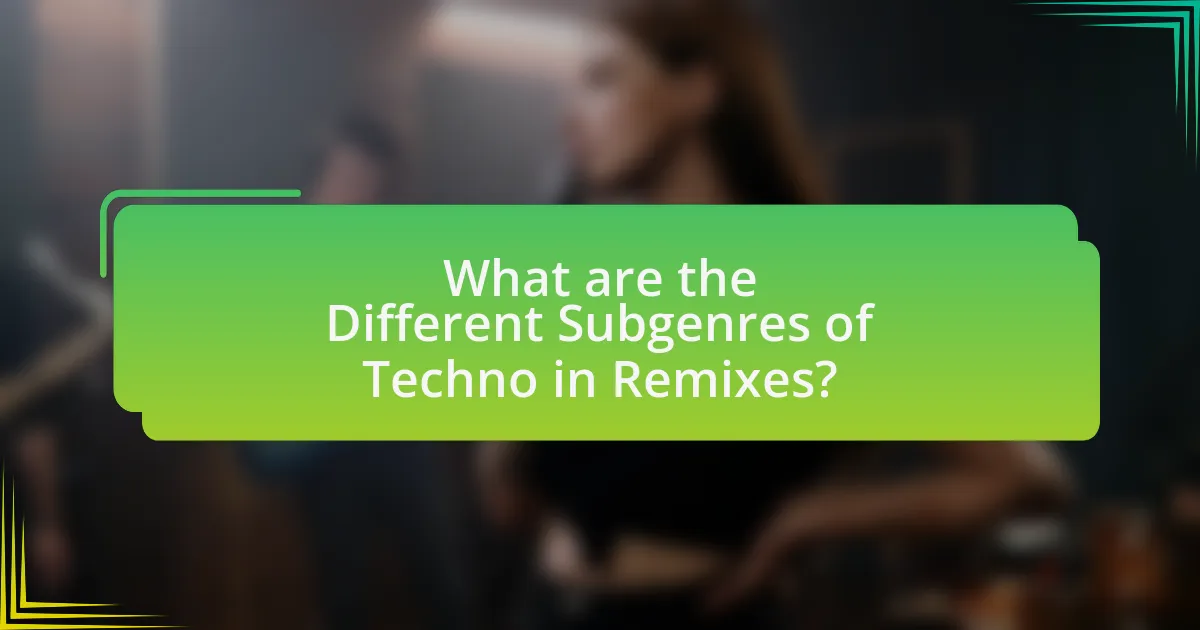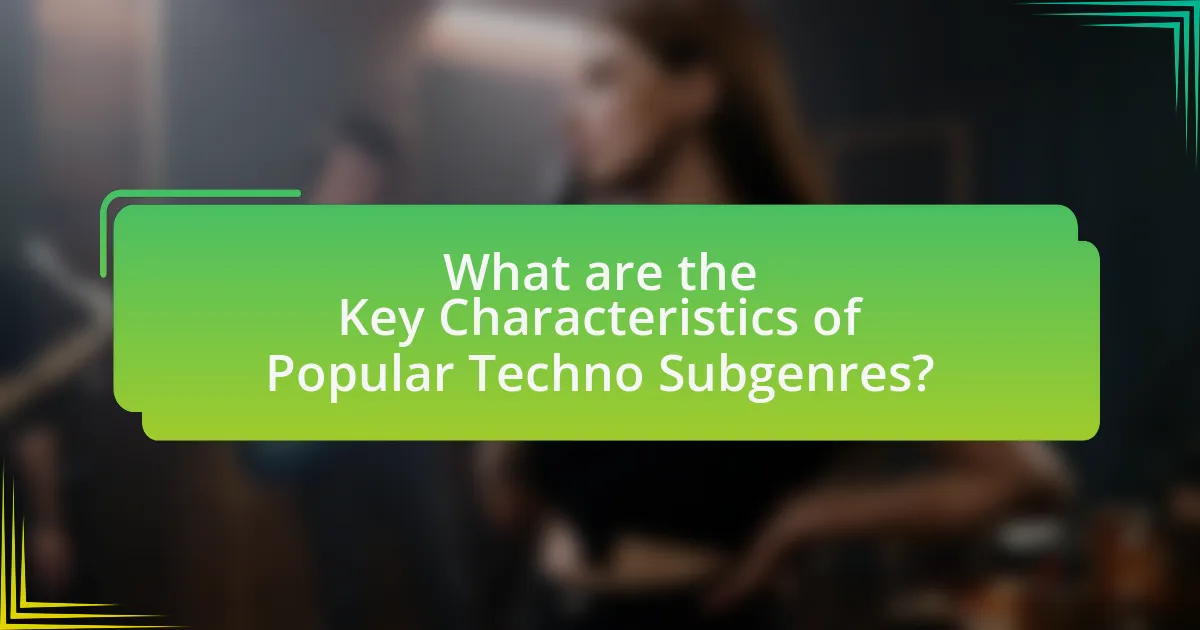The article explores the various subgenres of techno music as they relate to remixes, including Minimal Techno, Detroit Techno, Acid Techno, Tech House, and Industrial Techno. Each subgenre is characterized by distinct musical elements that influence the remixing process, allowing artists to experiment with different sounds and styles. The discussion highlights how these subgenres shape remix culture, impact listener preferences, and contribute to the evolution of techno music. Additionally, the article examines the techniques producers can use to incorporate subgenre elements while maintaining the essence of the original tracks.

What are the Different Subgenres of Techno in Remixes?
The different subgenres of techno in remixes include Minimal Techno, Detroit Techno, Acid Techno, Tech House, and Industrial Techno. Each subgenre has distinct characteristics; for example, Minimal Techno emphasizes simplicity and repetitive beats, while Detroit Techno incorporates soulful melodies and funk influences. Acid Techno is known for its use of the Roland TB-303 synthesizer, creating a distinctive squelching sound. Tech House blends elements of house music with techno, focusing on groove and rhythm, whereas Industrial Techno features harsh, mechanical sounds and a darker aesthetic. These subgenres reflect the diversity within the techno genre and influence the remixing process, allowing artists to explore various sonic landscapes.
How do subgenres of techno influence remix culture?
Subgenres of techno significantly influence remix culture by providing distinct sonic characteristics and thematic elements that shape the creative process of remixing. Each subgenre, such as minimal techno, acid techno, or Detroit techno, offers unique rhythmic structures, sound palettes, and emotional tones that remixers can draw upon to reinterpret original tracks. For instance, minimal techno’s emphasis on subtlety and texture encourages remixers to focus on intricate sound design, while acid techno’s use of the 303 bassline inspires more energetic and psychedelic remixes. This diversity in subgenres fosters a rich landscape for innovation, allowing artists to experiment and blend styles, ultimately enriching the overall remix culture within the electronic music scene.
What are the defining characteristics of each techno subgenre?
Techno subgenres are characterized by distinct musical elements and stylistic features.
-
Detroit Techno: Originating in the 1980s, it features melodic synthesizers, repetitive beats, and a futuristic sound, often influenced by funk and soul.
-
Minimal Techno: This subgenre emphasizes simplicity and subtlety, using fewer elements and focusing on rhythm and texture, creating a hypnotic effect.
-
Acid Techno: Defined by the use of the Roland TB-303 bass synthesizer, it incorporates squelchy basslines and psychedelic sounds, often with a faster tempo.
-
Tech House: A blend of techno and house music, it combines the rhythmic elements of techno with the grooves of house, featuring soulful vocals and melodic hooks.
-
Industrial Techno: Characterized by harsh, mechanical sounds and aggressive beats, it often incorporates elements from industrial music, creating a darker atmosphere.
-
Hard Techno: Known for its fast tempo and heavy bass, it features aggressive beats and is often associated with rave culture.
-
Dub Techno: This subgenre incorporates elements of dub music, featuring deep basslines, echo, and reverb, creating a spacious and atmospheric sound.
-
Ambient Techno: Merging ambient music with techno, it focuses on atmospheric soundscapes and slower tempos, often lacking a traditional beat structure.
Each subgenre reflects unique influences and production techniques, contributing to the diverse landscape of techno music.
How do these characteristics manifest in remixes?
Characteristics of different subgenres of techno manifest in remixes through variations in tempo, rhythm, and sound design. For instance, minimal techno remixes often emphasize stripped-down beats and subtle melodic elements, creating a hypnotic effect, while acid techno remixes incorporate the distinctive squelching sounds of the Roland TB-303 synthesizer, enhancing the energetic and psychedelic experience. Additionally, Detroit techno remixes may feature soulful vocal samples and lush synth pads, reflecting the genre’s roots in funk and soul music. These manifestations are evident in tracks like “Strings of Life” remixed by Derrick May, which showcases the blend of melodic complexity and driving beats characteristic of Detroit techno.
Why is it important to explore subgenres in techno remixes?
Exploring subgenres in techno remixes is important because it enhances creativity and diversity within the genre. By delving into various subgenres, artists can experiment with different sounds, structures, and rhythms, leading to innovative tracks that push the boundaries of traditional techno. For instance, the integration of elements from subgenres like minimal techno or acid techno can create unique remixes that appeal to a broader audience, thus expanding the listener base. Additionally, understanding subgenres allows producers to tailor their remixes to specific audiences, increasing the potential for commercial success and artistic recognition.
What role do subgenres play in the evolution of techno music?
Subgenres play a crucial role in the evolution of techno music by introducing diverse sounds, styles, and cultural influences that expand the genre’s boundaries. Each subgenre, such as minimal techno, acid techno, and Detroit techno, contributes unique characteristics that reflect technological advancements and shifts in listener preferences. For instance, minimal techno emerged in the 1990s, emphasizing stripped-down beats and subtle variations, which influenced mainstream electronic music and led to a broader acceptance of techno in various music scenes. This diversification allows artists to experiment and innovate, fostering a dynamic environment where new subgenres can emerge, thus continuously reshaping the techno landscape.
How do subgenres affect listener preferences and experiences?
Subgenres significantly influence listener preferences and experiences by catering to specific tastes and emotional responses. For instance, the diversity within techno subgenres, such as minimal, acid, and melodic techno, allows listeners to select styles that resonate with their mood or social context. Research indicates that listeners often gravitate towards subgenres that align with their personal identity and social circles, enhancing their overall enjoyment and engagement with the music. A study published in the Journal of Music and Meaning found that individuals who identify with specific subgenres report a stronger emotional connection and satisfaction, demonstrating how subgenre distinctions shape listener experiences.

What are the Key Characteristics of Popular Techno Subgenres?
Popular techno subgenres exhibit distinct characteristics that define their sound and style. For instance, Minimal Techno is characterized by its stripped-down aesthetic, focusing on repetitive beats and subtle variations, often creating a hypnotic effect. In contrast, Acid Techno incorporates the use of the Roland TB-303 synthesizer, producing squelchy basslines and psychedelic sounds. Detroit Techno, originating from Detroit in the 1980s, combines elements of funk, electro, and house, featuring melodic and rhythmic complexity. Tech House merges techno’s driving beats with house’s groove, resulting in a danceable yet deep sound. Each subgenre reflects unique cultural and historical influences, contributing to the rich diversity within the techno genre.
What distinguishes Minimal Techno from other subgenres?
Minimal Techno is distinguished from other subgenres by its emphasis on simplicity and minimalism in sound design, often featuring repetitive beats, sparse melodies, and a focus on texture rather than complexity. This subgenre prioritizes subtle variations and a hypnotic quality, contrasting with more melodic or aggressive forms of techno that incorporate richer layers and more pronounced musical elements. The origins of Minimal Techno can be traced back to the early 1990s, particularly influenced by artists like Richie Hawtin and the Detroit techno scene, which sought to strip down the sound to its essential components, thereby creating a unique auditory experience that is both immersive and meditative.
How does Minimal Techno influence remixing techniques?
Minimal Techno influences remixing techniques by emphasizing simplicity and subtlety, which encourages remixers to focus on minimalistic elements and intricate sound design. This subgenre often utilizes repetitive patterns and sparse arrangements, allowing remixers to creatively manipulate individual sounds and layers without overwhelming the listener. The use of space and silence in Minimal Techno also inspires remixers to explore dynamic contrasts, enhancing the emotional impact of their remixes. Additionally, the genre’s reliance on loop-based structures facilitates the integration of various samples and effects, enabling remixers to experiment with texture and rhythm while maintaining a cohesive sound.
What are notable examples of Minimal Techno remixes?
Notable examples of Minimal Techno remixes include Ricardo Villalobos’ remix of “The Man with the Red Face” by Laurent Garnier, which showcases intricate rhythms and subtle soundscapes characteristic of the genre. Another significant remix is the “Mango” remix by Villalobos of “Mango” by the artist, which emphasizes minimalistic elements and deep grooves. Additionally, the remix of “Falling” by the duo Pan-Pot highlights the genre’s ability to blend hypnotic beats with atmospheric textures. These remixes exemplify the essence of Minimal Techno, focusing on stripped-down sounds and repetitive motifs that engage listeners in a deep auditory experience.
What makes Acid Techno unique in the remix landscape?
Acid Techno is unique in the remix landscape due to its distinctive use of the Roland TB-303 synthesizer, which creates the characteristic squelchy basslines that define the genre. This sound allows for a wide range of creative reinterpretations in remixes, as producers can manipulate the 303’s parameters to produce various textures and rhythms. Additionally, Acid Techno often incorporates repetitive, hypnotic beats and psychedelic elements, making it particularly suited for extended mixes and live performances. The genre’s roots in the late 1980s and early 1990s rave culture further contribute to its unique position, as remixes often evoke nostalgia while pushing the boundaries of contemporary electronic music.
How do Acid elements transform traditional remixes?
Acid elements transform traditional remixes by introducing distinctive squelching sounds and complex, modulated basslines that redefine the sonic landscape. The incorporation of the Roland TB-303 synthesizer, a hallmark of Acid music, creates a unique tonal quality that adds depth and texture to remixes, making them more dynamic and engaging. This transformation is evident in tracks where Acid elements are blended with traditional genres, resulting in a fusion that enhances rhythmic complexity and emotional intensity, as seen in the works of artists like Phuture and Hardfloor, who pioneered Acid House in the late 1980s.
What are some iconic Acid Techno remixes to explore?
Some iconic Acid Techno remixes to explore include “Acid Eiffel” by Laurent Garnier, remixed by various artists, and “Higher State of Consciousness” by Josh Wink, which has multiple notable remixes. “The Age of Love” by Age of Love, particularly the Jam & Spoon remix, is also significant in the Acid Techno scene. These tracks exemplify the genre’s signature sound, characterized by the use of the Roland TB-303 synthesizer, which creates the distinctive squelchy basslines and hypnotic rhythms that define Acid Techno.
How does Tech House blend elements in remixes?
Tech House blends elements in remixes by integrating the rhythmic and melodic characteristics of house music with the minimalistic and percussive elements of techno. This fusion often results in a groove-oriented sound that emphasizes basslines, syncopated rhythms, and vocal samples, creating a dynamic listening experience. For instance, tracks may incorporate deep basslines typical of house while layering in the intricate hi-hats and claps found in techno, thus appealing to fans of both genres. The effectiveness of this blend is evidenced by the popularity of Tech House remixes in club settings, where they maintain danceability while offering a fresh take on familiar tracks.
What are the key features of Tech House remixes?
Tech House remixes are characterized by a blend of house and techno elements, featuring a steady four-on-the-floor beat, deep basslines, and minimalistic melodies. These remixes often incorporate vocal samples, syncopated rhythms, and atmospheric effects to create a groove-oriented sound. The genre emphasizes a smooth transition between tracks, maintaining energy while allowing for creative reinterpretation of original songs. Additionally, Tech House remixes frequently utilize looping techniques and layered textures, enhancing the overall sonic experience.
How do Tech House remixes differ from other techno subgenres?
Tech House remixes differ from other techno subgenres primarily through their incorporation of house music elements, characterized by a groovier bassline and a more melodic structure. Unlike traditional techno, which often emphasizes a driving beat and minimalistic sound, Tech House blends these rhythmic elements with soulful vocals and funk-inspired grooves, creating a more danceable and accessible sound. This fusion is evident in tracks that utilize samples from house music, resulting in a distinct vibe that appeals to a broader audience. The emphasis on rhythm and groove in Tech House remixes sets them apart from other subgenres like minimal techno or acid techno, which focus more on atmospheric soundscapes and repetitive patterns.

How do Remixes Reflect the Evolution of Techno Subgenres?
Remixes reflect the evolution of techno subgenres by showcasing the adaptability and innovation within the genre. Each remix often incorporates elements from various subgenres, such as minimal, acid, or Detroit techno, illustrating how artists blend styles to create new sounds. For instance, the rise of tech house in the early 2000s was significantly influenced by remixes that combined house beats with techno’s rhythmic complexity, demonstrating a fusion that appealed to diverse audiences. Additionally, remixes often highlight the technological advancements in music production, as seen with the use of software like Ableton Live, which allows for intricate layering and manipulation of sounds, further pushing the boundaries of techno subgenres. This ongoing remix culture not only preserves the essence of original tracks but also propels the genre forward, making it a dynamic and evolving musical landscape.
What trends are emerging in techno remixes today?
Emerging trends in techno remixes today include the integration of live instrumentation, the incorporation of ambient and experimental sounds, and the use of AI-generated elements. Live instrumentation is becoming more prevalent as artists seek to create a unique sound that differentiates their remixes from traditional electronic tracks. The blending of ambient and experimental sounds allows for a more immersive listening experience, appealing to a broader audience. Additionally, AI technology is being utilized to generate new sounds and patterns, pushing the boundaries of creativity in remixing. These trends reflect a shift towards innovation and a desire for distinctiveness in the techno genre.
How are contemporary artists redefining traditional subgenres?
Contemporary artists are redefining traditional subgenres by blending elements from various genres, incorporating innovative technology, and experimenting with new sounds. For instance, artists like Charlotte de Witte and Amelie Lens merge techno with industrial and trance influences, creating a hybrid sound that challenges the boundaries of traditional techno. Additionally, the use of digital tools and software allows for intricate sound design and manipulation, enabling artists to produce remixes that reflect personal styles while paying homage to the original subgenres. This evolution is evident in the rise of subgenres such as melodic techno and hard techno, which showcase diverse influences and appeal to a broader audience.
What impact do technological advancements have on remixing?
Technological advancements significantly enhance the process of remixing by providing tools that facilitate creativity and accessibility. Digital audio workstations (DAWs), software plugins, and online collaboration platforms enable artists to manipulate sounds, integrate various subgenres, and share their work globally. For instance, the rise of DAWs like Ableton Live and FL Studio has democratized music production, allowing both amateur and professional musicians to create high-quality remixes without the need for expensive studio equipment. Additionally, advancements in artificial intelligence have introduced automated mixing and mastering tools, streamlining the production process and enabling more intricate sound design. These developments have led to a proliferation of diverse techno remixes, as artists can easily experiment with different styles and techniques, ultimately enriching the genre.
How can understanding subgenres enhance remix creation?
Understanding subgenres enhances remix creation by providing specific stylistic elements and cultural contexts that can be incorporated into new works. Each subgenre of techno, such as minimal, acid, or Detroit techno, has distinct characteristics, including tempo, instrumentation, and production techniques. For instance, minimal techno emphasizes stripped-down beats and subtle variations, while acid techno features the iconic squelching sounds of the Roland TB-303 synthesizer. By grasping these nuances, remix artists can tailor their remixes to resonate more deeply with audiences familiar with those subgenres, thereby increasing the remix’s appeal and authenticity. This approach is supported by the fact that successful remixes often reflect a deep understanding of the original track’s genre and its subgenres, allowing for innovative reinterpretations that maintain the essence of the source material while introducing fresh elements.
What techniques can producers use to incorporate subgenre elements?
Producers can incorporate subgenre elements by utilizing specific sound design techniques, layering distinct rhythmic patterns, and integrating characteristic instrumentation. For instance, incorporating elements like acid basslines from Acid Techno or using the syncopated beats typical of Minimal Techno can effectively blend subgenres. Additionally, producers can manipulate tempo and structure to reflect the nuances of different subgenres, such as the slower, more atmospheric elements of Ambient Techno. These techniques are validated by the diverse approaches seen in successful remixes that draw from multiple subgenres, demonstrating the effectiveness of such methods in creating a cohesive yet varied sound.
How can remixers stay true to the essence of a subgenre?
Remixers can stay true to the essence of a subgenre by understanding and incorporating its defining characteristics, such as tempo, instrumentation, and stylistic elements. For example, in techno subgenres like minimal or acid techno, maintaining the specific rhythmic patterns and synthesizer sounds is crucial. Research indicates that successful remixes often reflect the original track’s emotional and sonic qualities, ensuring that the remix resonates with fans of the subgenre. By analyzing tracks within the subgenre and adhering to its foundational elements, remixers can create works that honor the genre’s integrity while adding their unique touch.
What are best practices for remixing within specific techno subgenres?
Best practices for remixing within specific techno subgenres include understanding the unique characteristics of each subgenre, maintaining the original track’s essence, and incorporating innovative elements that enhance the remix. For instance, in minimal techno, focus on subtle changes and atmospheric sounds, while in acid techno, utilize distinctive 303 basslines and repetitive patterns. Additionally, analyzing successful remixes within the subgenre can provide insights into effective techniques and sound design. This approach is supported by the fact that remixes that respect the original track while adding fresh elements tend to resonate better with audiences, as seen in the works of renowned artists like Richie Hawtin and Carl Cox.


